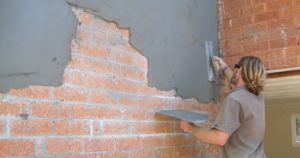Grout Plastering Pointing
GROUT
It is a cement mortar of fluid consistency. For repairs of cracks or fissures it is injected under pressure into the cracks. It also may be injected in the soil so as to increase its bearing capacity (it is known as soil stabilization). Empty joints in masonry left due to bad workmanship are filled up by grouting. To fill up bigger cracks, a little coarse aggregate may also be added to it.
PLASTERING
Masonry and concrete surfaces have often to be plastered to give protection to the masonry & concrete surfaces and to improve appearance. The surface to be plastered should be clean, free from dust, loose material and greasy spots. If required, the surface should be washed and brushed. To provide a key to the plaster all joints in the masonry should be raked out to a depth of about 1.25 cm when the mortar is still not set. In case the surface is to be plastered with cement mortar or lime mortar, the surface should be wetted for a few hours. Excessive wetting should be avoided as the plastering does not stick well to such surface.
Plaster may be applied in one or more coats but the thickness of a single coat should not exceed 1.25 cm. In case more than one coat of plaster are being applied then no coat should be applied before the previous one has attained full setting and shrinkage. Scratches should be made on the coat of plaster (over which another coat is to come) when it is still green. This is done so as to provide key to the next coat of plaster. Fine sand used in cement plaster gives as good finish but if the sand is too fine then the plaster shall have shrinkage cracks.
Cement plaster should preferably be gauged with fat lime which would reduce shrinkage cracks and improve work-ability but it would make the setting of plaster slow. Use of very fine sand would further slow down the setting of plaster. Freshly applied plaster should be protected from excessive winds, direct sun or frost. It should be cured for no. of days.
POINTING
It is the filling up of masonry joints, raked out to a depth of at least 1.25 cm, with the same mortar as used in masonry or a different one. It is done primarily to seal off the cavities left in the mortar joint thereby stopping the entry of moisture inside the wall. Also the purpose of pointing the masonry is to improve the appearance of the surface. Sometimes the masonry surface is not desired to be plastered due to many reasons and is simply pointed. Cement mortar, lime mortar or lime mortar gauged with cement may be used for pointing.
Click here to See All Construction Materials Notes
Grout Plastering Pointing, Grout Plastering Pointing, Grout Plastering Pointing, Grout Plastering Pointing, Grout Plastering Pointing, Grout Plastering Pointing, Grout Plastering Pointing, Grout Plastering Pointing, Grout Plastering Pointing, Grout Plastering Pointing, Grout Plastering Pointing,


